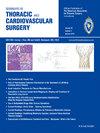Prognostic Impact of Clinicopathological and Inflammatory Markers in Surgically Treated Pulmonary Invasive Mucinous Adenocarcinoma.
IF 2.5
3区 医学
Q2 CARDIAC & CARDIOVASCULAR SYSTEMS
Seminars in Thoracic and Cardiovascular Surgery
Pub Date : 2025-09-18
DOI:10.1053/j.semtcvs.2025.08.007
引用次数: 0
手术治疗的肺浸润性粘液腺癌的临床病理和炎症标志物对预后的影响。
目的:浸润性肺粘液腺癌(IMA)是一种罕见的组织学亚型,占肺腺癌的2-10%,具有独特的分子和临床病理特征。由于其罕见性和发表的研究数量有限,不可能进行前瞻性研究。因此,接受手术的IMA患者的预后指标仍不清楚。方法:回顾性分析2020年5月至2024年12月期间接受手术的组织病理学证实的纯IMA患者的数据。计算人口学数据、肿瘤大小、定位、淋巴结状态、内脏胸膜侵犯[VPI]、空域扩散[STAS]、辅助治疗以及其他癌症类型中被认为是预后的血液学指标。采用Kaplan-Meier法计算估计DFS和OS, Cox回归分析预后因素。结果:共纳入53例手术切除的粘液腺癌患者。中位年龄为66岁(范围:36-88岁)。其中男性54.7% (n = 29),女性45.3% (n = 24)。辅助化疗19例(35.8%),辅助放疗7例(13.2%)。术后病理检查显示肿瘤直径≥4cm 24例(45.3%),淋巴结转移6例(11.3%),stas阳性10例(18.9%)。总体人群的估计中位无病生存期(mDFS)为98.9个月。在有淋巴结转移的患者中,mDFS为4.5个月,而无淋巴结受累的患者中位数未达到(log-rank, p )结论:结论:虽然淋巴结转移、内脏胸膜浸润和STAS存在被认为是IMA患者预后不良的指标,但炎症标志物不能预测预后。
本文章由计算机程序翻译,如有差异,请以英文原文为准。
求助全文
约1分钟内获得全文
求助全文
来源期刊

Seminars in Thoracic and Cardiovascular Surgery
Medicine-Pulmonary and Respiratory Medicine
CiteScore
5.80
自引率
0.00%
发文量
324
审稿时长
12 days
期刊介绍:
Seminars in Thoracic and Cardiovascular Surgery is devoted to providing a forum for cardiothoracic surgeons to disseminate and discuss important new information and to gain insight into unresolved areas of question in the specialty. Each issue presents readers with a selection of original peer-reviewed articles accompanied by editorial commentary from specialists in the field. In addition, readers are offered valuable invited articles: State of Views editorials and Current Readings highlighting the latest contributions on central or controversial issues. Another prized feature is expert roundtable discussions in which experts debate critical questions for cardiothoracic treatment and care. Seminars is an invitation-only publication that receives original submissions transferred ONLY from its sister publication, The Journal of Thoracic and Cardiovascular Surgery. As we continue to expand the reach of the Journal, we will explore the possibility of accepting unsolicited manuscripts in the future.
 求助内容:
求助内容: 应助结果提醒方式:
应助结果提醒方式:


